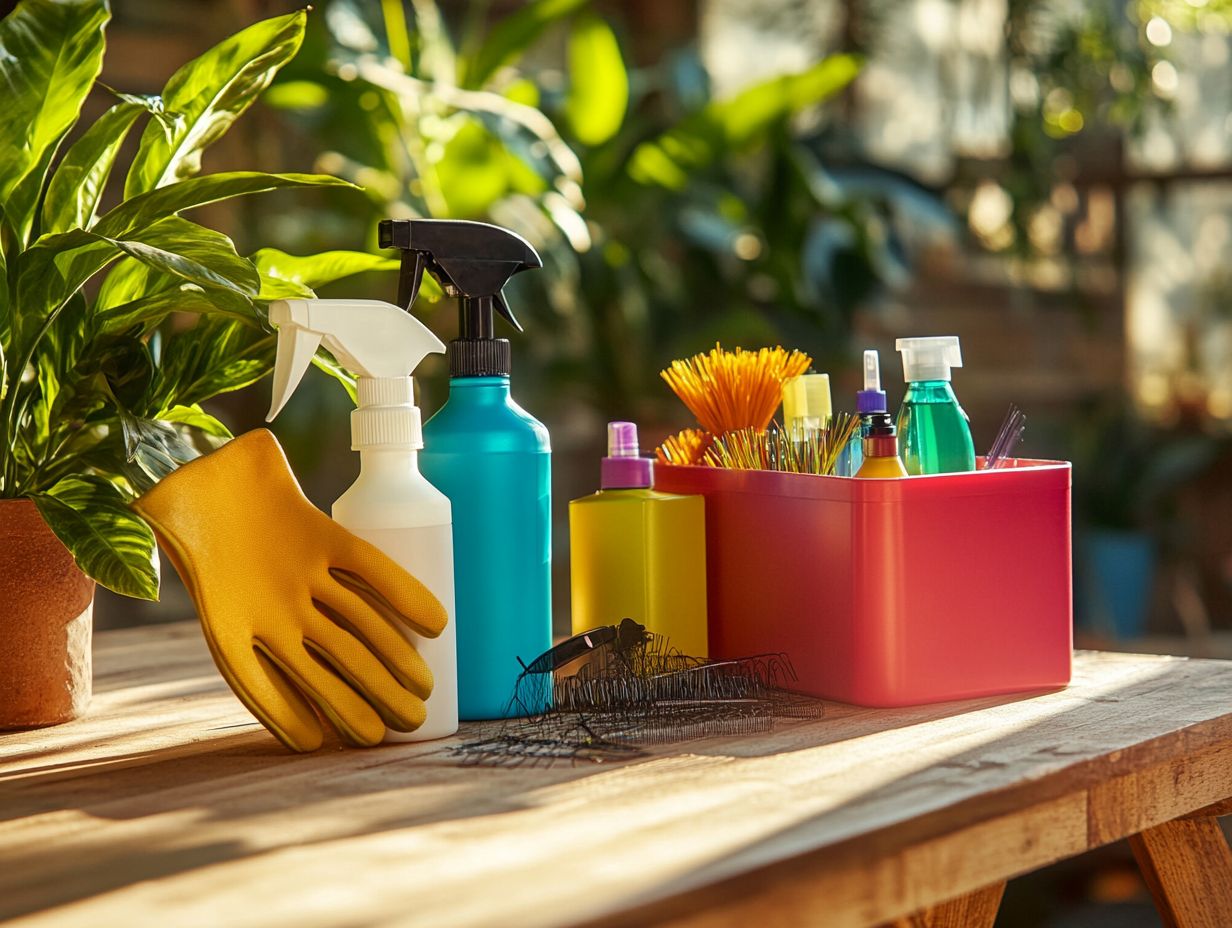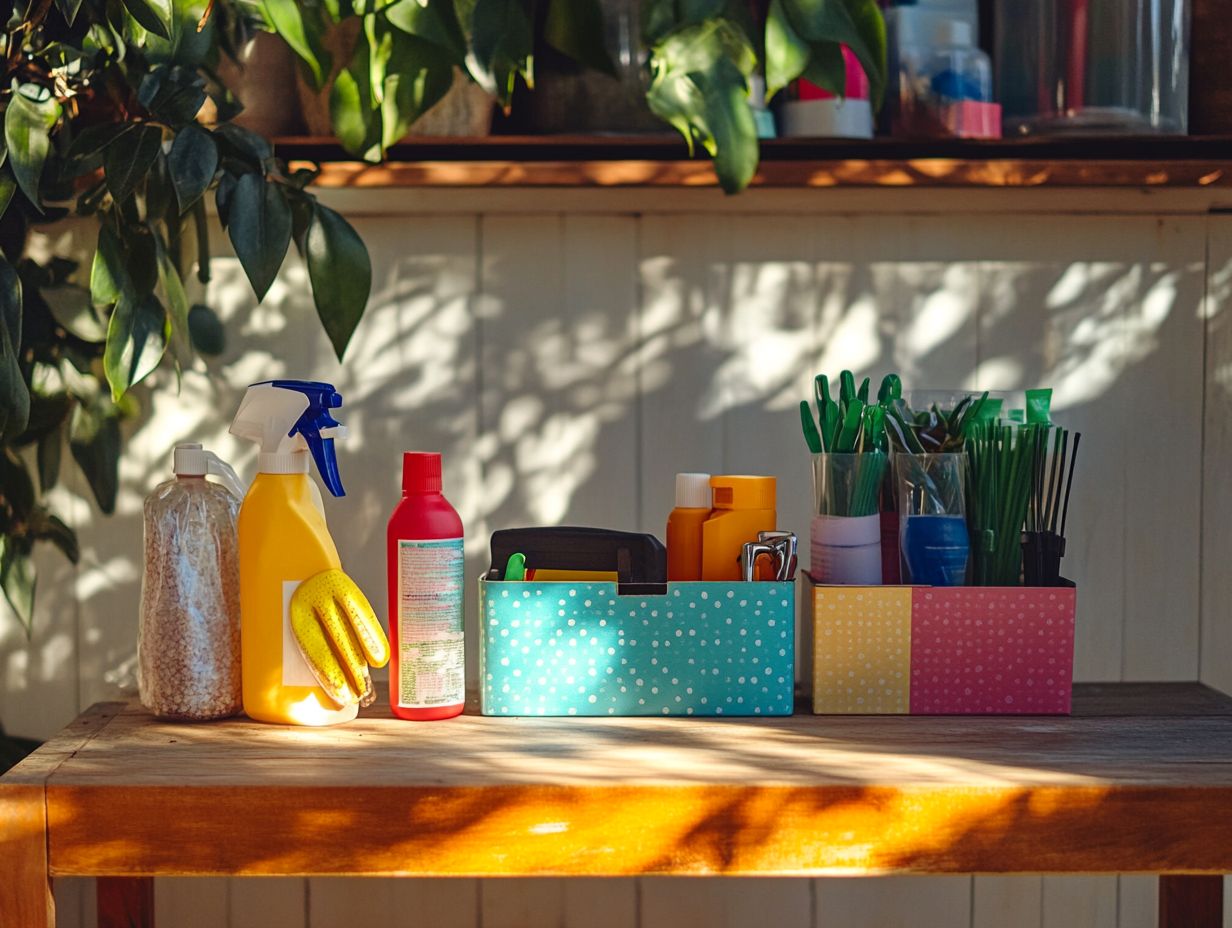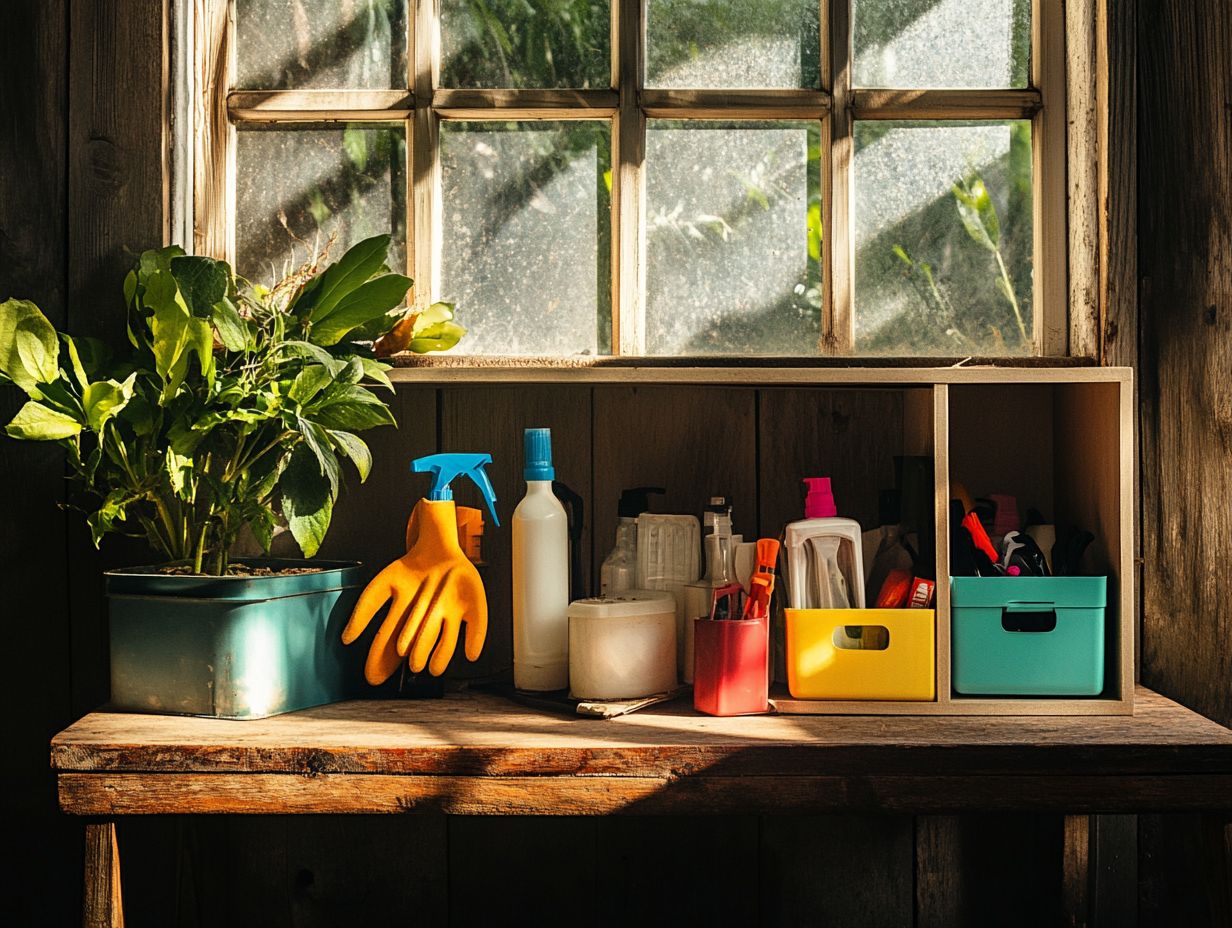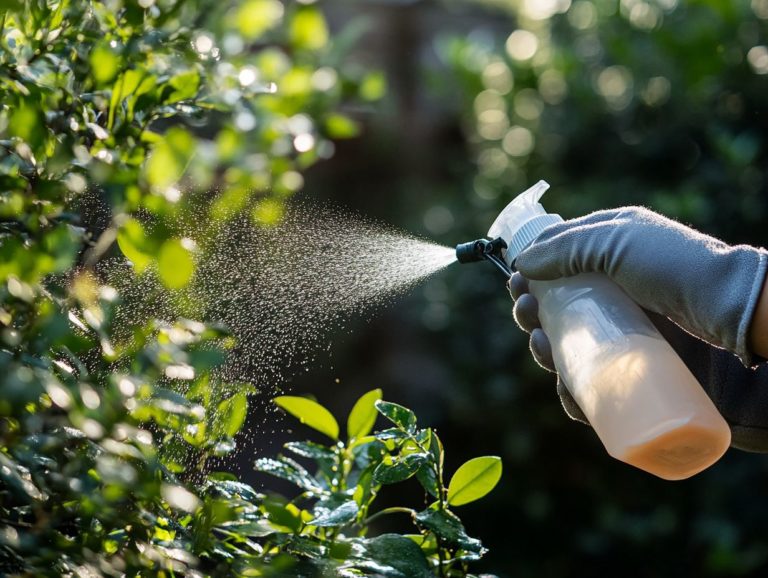How to Create an Indoor Pest Control Kit
Indoor pests can quickly transform your cozy haven into an exasperating battleground. From ants parading through your kitchen to rodents darting in the shadows, grasping their behaviors is crucial for effective control.
This guide will equip you with the essentials of indoor pest control, enabling you to identify common pests, gather the necessary tools, and build your very own pest control kit.
With practical tips and proactive strategies, you’ll discover how to maintain a pest-free environment and keep those unwelcome visitors at bay.
Dive in to uncover everything you need for effective pest management!
Contents
- Key Takeaways:
- Understanding Indoor Pests
- Essential Tools for Indoor Pest Control
- Creating Your Indoor Pest Control Kit
- Using Your Indoor Pest Control Kit
- Maintaining Your Indoor Pest Control Kit
- Preventing Indoor Pests
- Frequently Asked Questions
- What is a pest control kit and how does it include essential tools for effective management?
- Why is it important to have a pest control kit?
- How do I create a pest control kit?
- What types of insecticides should I include in my kit?
- How often should I update my pest control kit?
- How can I use my pest control kit effectively?
Key Takeaways:

- Understand the behavior and types of indoor pests to effectively combat them.
- Build your pest control kit with essential tools and follow simple steps for great results.
- Regularly maintain and restock your kit, and take proactive measures to prevent indoor pests from infesting your home.
Understanding Indoor Pests
Let’s dive into indoor pests, which are key to controlling them. These unwelcome guests can invade your home and disturb your peace.
Common pests include cockroaches and carpenter ants, which can cause serious property damage if not handled quickly. Familiarizing yourself with their behaviors and habitats gives you the power to implement effective preventive measures.
Prioritizing environmentally friendly products enhances safety and maintains high standards for pest control.
Common Types and Behaviors
Common indoor pests, like cockroaches and carpenter ants, have distinct behaviors that signal their unwelcome presence.
For instance, cockroaches are active at night and tend to scurry around once the lights dim. Their droppings, resembling little specks of pepper, are unmistakable indicators of an infestation.
Carpenter ants leave behind sawdust-like shavings as they tunnel through wood. This can potentially cause structural damage that may go unnoticed until it becomes a serious issue.
Setting traps can help you monitor and curb their populations effectively. Additionally, sealing off entry points and maintaining a clean environment discourages these pesky invaders from taking up residence in your home.
Essential Tools for Indoor Pest Control
Equipping yourself with the right essential tools for indoor pest control can truly transform how you handle pest issues. A well-curated pest control kit should feature premium products, including advanced engineered formulas and top-tier pesticides, all designed for safe use.
As DIY pest control rises in popularity, having proper safety information and application instructions is crucial, ensuring your efforts are both effective and responsible, especially when dealing with potential active infestations.
Must-Have Items for Your Kit
Your pest control kit should contain essential items like applicator spray wands and non-latex gloves to apply chemicals safely and effectively.
Incorporating protective eyewear, like goggles, is crucial to shield your eyes from any harmful substances released during pest management activities. A sturdy dust mask helps prevent inhalation of irritating particles or chemicals, fostering a safer working environment.
If you’re leaning towards a more eco-friendly approach, consider adding natural alternatives such as diatomaceous earth, a natural powder made from tiny fossilized sea creatures that helps control pests, and essential oils. These options provide effective pest deterrence without the harsh side effects associated with conventional chemicals.
When you bring all these elements together, you create a comprehensive pest control kit that gives you the power to tackle infestations responsibly and sustainably.
Let s get started today! You ll be amazed at how easy it is to reclaim your space from pests.
Creating Your Indoor Pest Control Kit

Creating your indoor pest control kit is an essential step in maintaining a pest-free home while utilizing effective products. Consider the coverage area of the products you choose; they should be tailored to your property’s specific needs and pest concerns.
Seek pest control services that provide robust products accompanied by a 90-day guarantee. This offers you assurance that your pest problems will be resolved efficiently and effectively.
Step-by-Step Guide
This step-by-step guide will lead you through assembling an effective indoor pest control kit. It ensures you have all the essential items on hand for ongoing pest management.
You ll start by understanding the key components necessary for a comprehensive pest control strategy. You’ll also explore effective techniques that cover all bases. Begin by gathering critical items such as traps, sprays, and barriers specifically designed to target common household pests.
Equip yourself with essential tools like gloves, masks, and measuring cups to guarantee a safe application. It’s wise to incorporate preventive measures such as sealing entry points and keeping your living space clean to minimize the risk of infestations.
Finally, familiarize yourself with maintenance strategies that include regular checks and timely replenishment of your kit. This proactive approach helps you keep pest issues at bay for the long haul.
Using Your Indoor Pest Control Kit
Using your indoor pest control kit effectively gives you the power to tackle pest issues. This minimizes their impact on your home environment.
Adhering to the proper treatment guidelines and safety information is essential for achieving successful outcomes.
By implementing DIY pest control strategies, you not only save money but also equip yourself with effective solutions to eliminate unwanted pests.
Tips and Tricks for Effective Pest Control
To achieve effective pest control, incorporating specific tips and tricks can significantly elevate your efforts and outcomes.
Regular inspections should be your top priority. They enable you to identify potential infestations early on and prevent them from escalating into more significant issues.
It s equally important to keep your home clean. This means keeping surfaces free from food debris and promptly addressing spills. Proper waste management is essential in deterring pests.
By disposing of trash correctly and ensuring that bins are tightly sealed, you minimize attractants that could lure unwanted visitors. These combined strategies foster a proactive approach, promoting a pest-free environment and safeguarding your living space.
Maintaining Your Indoor Pest Control Kit
Maintaining your indoor pest control kit is crucial for ensuring its effectiveness and immediate readiness when pest issues arise. Regularly check and replace items in your kit to avoid relying on ineffective or expired pest control products.
Learn the safety information related to chemical use. This will enhance both the safety and effectiveness of your pest control methods.
Replacing and Restocking Items

Regularly replacing and restocking items in your pest control kit ensures that you re always prepared to tackle any pest-related issues that may arise.
This proactive approach helps maintain strong defenses against pests. It also reduces the risk of infestations getting out of hand.
Make sure to assess your coverage area and pinpoint the specific pest control needs that may vary by season or location. For example, if your area tends to experience a termite influx during certain months, having the appropriate treatment supplies readily available can make all the difference.
Keeping a close eye on your stock levels and replacing items as they run low be it sprays, traps, or baits will fortify your pest control strategy. This allows for swift action whenever necessary, especially with Termidor for effective treatment.
Preventing Indoor Pests
Preventing indoor pests is crucial for effective pest management. It saves you time, effort, and potential financial headaches.
By implementing robust preventive measures like sealing cracks, maintaining cleanliness, and conducting regular inspections you can greatly diminish the chances of an unwelcome pest invasion.
Using chemical methods wisely can boost your prevention strategies, ensuring your home stays free of pests.
Proactive Measures to Keep Pests Away
Let’s jump right into how to keep your home pest-free!
Using good waste management practices reduces food accessibility for unwanted invaders.
Utilizing outdoor bait stations can significantly decrease pest populations before they ever set foot inside your home.
Deploying indoor traps serves as a strategic method to monitor and manage pest activity.
By integrating these pest control techniques into your routine, you create a multi-layered defense that deters pests and promotes a healthier home for everyone.
Frequently Asked Questions
What is a pest control kit and how does it include essential tools for effective management?
A pest control kit is a collection of tools and products that help you get rid of pests inside your home. It typically includes items such as insecticides, traps, baits, and protective gear.
Why is it important to have a pest control kit?

Having a pest control kit is important because pests can carry diseases, damage property, and cause discomfort. With a kit readily available, you can quickly address pest issues and prevent infestations from occurring.
How do I create a pest control kit?
To create a pest control kit, gather essential items like insecticides, traps, baits, gloves, and a dust mask.
It is also helpful to have a spray bottle, flashlight, and a container to hold all the items in one place.
What types of insecticides should I include in my kit?
The types of insecticides you include depend on the pests you are trying to control. Common options are sprays, dusts, and baits specifically designed for indoor use.
Always read the label and follow the instructions for safety!
How often should I update my pest control kit?
Update your pest control kit at least once a year or as needed. Check the expiration dates on products and replace any that have expired.
Replenish any items that have been used up or are no longer effective.
How can I use my pest control kit effectively?
To use your pest control kit effectively, first identify the type of pest you are dealing with and their entry points.
Then, follow the instructions on each product carefully and take necessary safety precautions.
Regularly inspect and maintain your home to prevent future pest problems.
Start building your kit today for a pest-free tomorrow!






